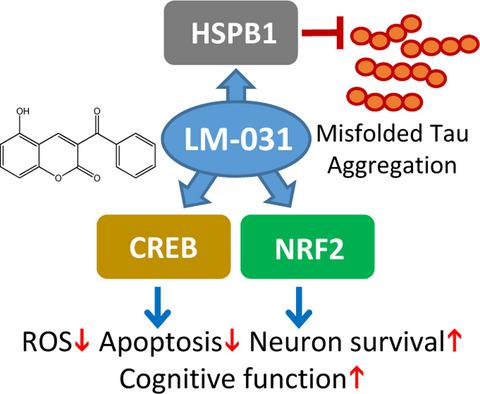当前位置:
X-MOL 学术
›
Aging Cell
›
论文详情
Our official English website, www.x-mol.net, welcomes your
feedback! (Note: you will need to create a separate account there.)
Exploration of multi-target effects of 3-benzoyl-5-hydroxychromen-2-one in Alzheimer's disease cell and mouse models.
Aging Cell ( IF 8.0 ) Pub Date : 2020-06-04 , DOI: 10.1111/acel.13169 Te-Hsien Lin,Ya-Jen Chiu,Chih-Hsin Lin,Chung-Yin Lin,Chih-Ying Chao,Yu-Chieh Chen,Shu-Mei Yang,Wenwei Lin,Hsiu Mei Hsieh-Li,Yih-Ru Wu,Kuo-Hsuan Chang,Guey-Jen Lee-Chen,Chiung-Mei Chen
Aging Cell ( IF 8.0 ) Pub Date : 2020-06-04 , DOI: 10.1111/acel.13169 Te-Hsien Lin,Ya-Jen Chiu,Chih-Hsin Lin,Chung-Yin Lin,Chih-Ying Chao,Yu-Chieh Chen,Shu-Mei Yang,Wenwei Lin,Hsiu Mei Hsieh-Li,Yih-Ru Wu,Kuo-Hsuan Chang,Guey-Jen Lee-Chen,Chiung-Mei Chen

|
Microtubule‐associated protein Tau, abundant in the central nervous system (CNS), plays crucial roles in microtubule assembly and stabilization. Abnormal Tau phosphorylation and aggregation are a common pathogenic hallmark in Alzheimer's disease (AD). Hyperphosphorylation of Tau could change its conformation and result in self‐aggregation, increased oxidative stress, and neuronal death. In this study, we examined the potential of licochalcone A (a natural chalcone) and five synthetic derivatives (LM compounds) for inhibiting Tau misfolding, scavenging reactive oxygen species (ROS) and providing neuroprotection in human cells expressing proaggregant ΔK280 TauRD‐DsRed. All test compounds were soluble up to 100 μM in cell culture media and predicted to be orally bioavailable and CNS‐active. Among them, licochalcone A and LM‐031 markedly reduced Tau misfolding and associated ROS, promoted neurite outgrowth, and inhibited caspase 3 activity in ΔK280 TauRD‐DsRed 293 and SH‐SY5Y cells. Mechanistic studies showed that LM‐031 upregulates HSPB1 chaperone, NRF2/NQO1/GCLC pathway, and CREB‐dependent BDNF/AKT/ERK/BCL2 pathway in ΔK280 TauRD‐DsRed SH‐SY5Y cells. Decreased neurite outgrowth upon induction of ΔK280 TauRD‐DsRed was rescued by LM‐031, which was counteracted by knockdown of NRF2 or CREB. LM‐031 further rescued the downregulated NRF2 and pCREB, reduced Aβ and Tau levels in hippocampus and cortex, and ameliorated cognitive deficits in streptozocin‐induced hyperglycemic 3 × Tg‐AD mice. Our findings strongly indicate the potential of LM‐031 for modifying AD progression by targeting HSPB1 to reduce Tau misfolding and activating NRF2 and CREB pathways to suppress apoptosis and promote neuron survival, thereby offering a new drug development avenue for AD treatment.
中文翻译:

探索3-苯甲酰基-5-羟色胺-2-酮在阿尔茨海默氏病细胞和小鼠模型中的多靶点作用。
微管相关蛋白Tau在中枢神经系统(CNS)中丰富,在微管组装和稳定中起着关键作用。Tau磷酸化和聚集异常是阿尔茨海默氏病(AD)的常见致病标志。Tau的过度磷酸化可能会改变其构象,并导致自身聚集,氧化应激增加和神经元死亡。在这项研究中,我们研究了licochalcone A(天然查尔酮)和五种合成衍生物(LM化合物)抑制Tau错折叠,清除活性氧(ROS)并在表达前体ΔK280Tau RD的人类细胞中提供神经保护的潜力。‐DsRed。所有测试化合物在细胞培养基中的溶解度最高可达100μM,并预计具有口服生物利用度和CNS活性。其中,利可考酮A和LM-031在ΔK280Tau RD -DsRed 293和SH-SY5Y细胞中显着减少Tau错折叠和相关的ROS,促进神经突生长,并抑制caspase 3活性。机理研究表明,LM-031在ΔK280Tau RD -DsRed SH-SY5Y细胞中上调HSPB1分子伴侣,NRF2 / NQO1 / GCLC途径和CREB依赖的BDNF / AKT / ERK / BCL2途径。诱导ΔK280Tau RD减少神经突生长‐DsRed被LM-031营救,但遭到NRF2或CREB的抑制。LM-031进一步挽救了下调的NRF2和pCREB,降低了海马和皮层的Aβ和Tau水平,并减轻了链佐星诱导的高血糖3×Tg-AD小鼠的认知功能障碍。我们的发现有力地表明,LM-031通过靶向HSPB1来减少Tau错折叠并激活NRF2和CREB途径来抑制细胞凋亡并促进神经元存活,从而改善AD进展,从而为AD治疗提供了新的药物开发途径。
更新日期:2020-06-04
中文翻译:

探索3-苯甲酰基-5-羟色胺-2-酮在阿尔茨海默氏病细胞和小鼠模型中的多靶点作用。
微管相关蛋白Tau在中枢神经系统(CNS)中丰富,在微管组装和稳定中起着关键作用。Tau磷酸化和聚集异常是阿尔茨海默氏病(AD)的常见致病标志。Tau的过度磷酸化可能会改变其构象,并导致自身聚集,氧化应激增加和神经元死亡。在这项研究中,我们研究了licochalcone A(天然查尔酮)和五种合成衍生物(LM化合物)抑制Tau错折叠,清除活性氧(ROS)并在表达前体ΔK280Tau RD的人类细胞中提供神经保护的潜力。‐DsRed。所有测试化合物在细胞培养基中的溶解度最高可达100μM,并预计具有口服生物利用度和CNS活性。其中,利可考酮A和LM-031在ΔK280Tau RD -DsRed 293和SH-SY5Y细胞中显着减少Tau错折叠和相关的ROS,促进神经突生长,并抑制caspase 3活性。机理研究表明,LM-031在ΔK280Tau RD -DsRed SH-SY5Y细胞中上调HSPB1分子伴侣,NRF2 / NQO1 / GCLC途径和CREB依赖的BDNF / AKT / ERK / BCL2途径。诱导ΔK280Tau RD减少神经突生长‐DsRed被LM-031营救,但遭到NRF2或CREB的抑制。LM-031进一步挽救了下调的NRF2和pCREB,降低了海马和皮层的Aβ和Tau水平,并减轻了链佐星诱导的高血糖3×Tg-AD小鼠的认知功能障碍。我们的发现有力地表明,LM-031通过靶向HSPB1来减少Tau错折叠并激活NRF2和CREB途径来抑制细胞凋亡并促进神经元存活,从而改善AD进展,从而为AD治疗提供了新的药物开发途径。











































 京公网安备 11010802027423号
京公网安备 11010802027423号